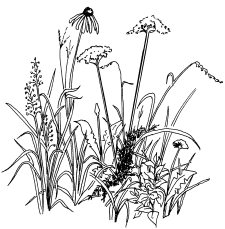
Indicator Species
Nine-banded Armadillo: Dasypus novemcinctus
IUCN (International Union for the Conservation of Nature) status: Least Concern.
Natural history:
A generalist mammal that has expanded northward from Mexico since the early 1900s. They primarily feed on invertebrates such as grubs, beetles, ants, and worms but will adapt their diet as food is opportunistically encountered. They have been documented eating bird eggs, lizards, amphibians, and occasionally tubers and roots of plants. They are occasionally preyed upon by other mammals or large birds of prey, but they are well protected with their armored shell.
Habitat:
This species has shown to be extremely successful. Traditionally associated with the tropical or desert southern states, they now are found in woodland, grassland, and even suburban areas. Their poor eyesight and defensive jumping posture leads to frequent roadkill. They cannot hibernate and do not fair well with extended snow/ice cover. They have a high reproductive rate.
Range:
First seen in Missouri in the mid 1990’s they have expanded their range north to Nebraska and east into the Carolinas.
http://maps.iucnredlist.org/map.html?id=6290
Links:
http://animals.nationalgeographic.com/animals/mammals/armadillo/
https://en.wikipedia.org/wiki/Nine-banded_armadillo
http://www.iucnredlist.org/details/6290/0
http://armadillo-online.org/expansion.html
Guiding questions for predicting the future of this species at Tucker Prairie:
-
Does this species account lend evidence to support the ability to adapt to changing vegetation, soil moisture, and climate?
-
Are the habitat requirements for this species broad or specific?
-
What is your prediction for the success of this species at Tucker Prairie if climate change results in a gradual conversion of Tucker Prairie from native prairie to shrubs and eventually woodland?
-
What does this species eat? What other species eats the armadillo?
-
What cascading impacts might the introduction of this generalist species have on the ecosystem at Tucker prairie?
-
Why should we care about changes in the population of a mammal like the armadillo? Socially is this important or not? Why?


